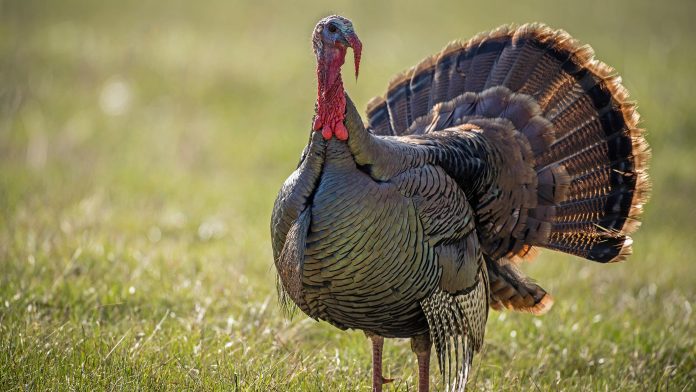We may earn revenue from the products available on this page and participate in affiliate programs. Learn more ›
While the spring turkey hunt is in the rearview mirror for Southern hunters, things are still going strong in other areas of the country. But even where the season is still open, it can be hard to talk yourself into hitting the woods. The gobbling peak is past. The vast majority of hens have been bred and most are sitting on eggs. And other, more summer-like activities beckon, like fishing and, for some, more inane distractions like gardening and golf.
But right now, at the tail end of May, hunters with the moxie to keep going can have some incredible action. The competition for remaining hens can be fierce among gobblers, and in some places toms are even forming bachelor groups, which creates a dynamic not seen since the earliest hunts of the season (and not at all in some climes, depending on a state’s opener). In short, it’s not time to stow the gun and calls just yet. Instead, it’s time to fill that last tag.
The Pro: Scott Bestul, F&S Field Editor

That’s right, your gobbler hunting guru for this Best Day of the Strut is yours truly. I probably haven’t taken quite as many gobblers or won as many calling contests as the previous experts in this series, but when the yardstick is hunting endurance, I can hold my own. I’ve been plugging away at the sport since the early 1980’s, when I drew tags for the first spring hunts ever in Iowa and Minnesota. To do so, I had to take an education class on turkey biology and hunting safety because almost no one knew anything about turkeys. I got hooked immediately and have since hunted in over a dozen states and tagged several grand slams.
The Strut Stage: Nesting/Pickup Breeding
As noted above, the vast majority of hens have laid their eggs and are “setting,” which in effect takes them out of the breeding equation. This makes for fierce competition among gobblers for any late-breeding hens (which can include some early nesters who’ve lost their clutch to a nest predator or other disaster). In areas where virtually all hens are setting, gobblers may have sighed, given up, and started gathering in the guy-groups that they’ll maintain for the rest of the year.
Expert Tactic for May 29: Go Late and Get Your Longbeard
Turkey hunting and watching the sun rise go together, but by now it’s been a long season, and with much later sunsets and way-too-early sunrises, getting up to watch a new day come in has lost some of its luster. Then I leafing through some old F&S magazines and read my colleague Phil Bourjaily’s “Hunting Between the Buses”, a story that chronicled his midday turkey hunting journeys that didn’t start until after he dropped his kids off at the schoolbus each morning and ended in time for him to pick the boys up that afternoon. Bourjaily became my gobbler guru with that piece, which made me realize you can still kill toms without setting your alarm for the middle of the night.
Sure, it’s part laziness, but that’s not all of it. I’ve hunted plenty of late-May daybreaks, and birds simply don’t gobble as much as they did before. So, unless I’ve roosted a gobbler the night before, I’ll sleep in a little, arrive well after sunup, and set up in an area of good gobbler activity—places I have catalogued after a full season’s worth of intel.
Then I just start running calls until I strike a gobbler. There’s no subtlety happening here. I like a loud, yawpy box call or a high-pitched pot call that can ring out turkey talk that’ll cover distance and cut through foliage to elicit a gobble. Some mornings this happens almost immediately, others I might have to hunt morels for a bit, or read a chapter or two from a paperback. If I’m feeling antsy and don’t provoke a gobble in short order, I’ll pull up stakes and move to another farm or public tract. I’m not expecting a cacophony of gobbling, just that one bird who’s feeling it that morning and is ready to play.
When I strike that bird, my first move is to hunker down immediately or search for a good setup nearby. Outside of early season, this is the one time where I’ve seen gobblers cover massive distances, often in short order, to reach the hen sounds they’ve heard. More than once I’ve tried to cut the distance to a tom, only to meet him halfway as he was doing the same to me. If, after an extended period, or repeated gobbles from a bird that’s clearly planted his feet, I’ll use terrain and lush foliage (another advantage of late May) to cut the distance.

But—and this can be important—sometimes hen talk won’t make a bird budge, but a gobble will. Two springs ago, I was hosting my friend Brian Lovett for a late-May hunt. We’d wiggled close to a bird that had gobbled off and on all morning, and when we finally got tight to him and yelped, he gobbled immediately. But after roaring several times, he moved off. We were mystified, thinking we’d somehow bumped the turkey. But then we heard multiple birds gobbling and coming in hot. Only a minute or two later, six longbeards came trotting in, a boy-band that had no interest in our yelping, or our hen decoy; they’d arrived to beat up on our gobbler and that was the reason he’d slunk off. Fortunately their crusade put them well within gun range, and when Brian dropped the lead tom I looked at my watch. It was 10:55, which meant we could choose from the breakfast or the lunch menu at the local diner.








